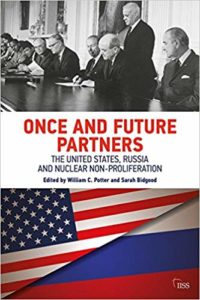Updated August 1, 2018
Once and Future Partners edited by William C. Potter and Sarah Bidgood
Despite their Cold War rivalry, the United States and the Soviet Union frequently engaged in joint efforts to prevent the spread of nuclear weapons. Leaders in Washington and Moscow recognized that nuclear proliferation would serve neither country’s interests even when they did not see eye-to-eye in many other areas. They likewise understood why collaboration in mitigating this nuclear danger would serve both their own interests and those of the international community.
This volume examines seven little known examples of US-Soviet cooperation for non-proliferation, including preventing South Africa from conducting a nuclear test, developing international safeguards and export control guidelines, and negotiating a draft convention banning radiological weapons. It uses declassified and recently-digitized archival material to explore in-depth the motivations for and modalities for cooperation under often adverse political circumstances.
Given the current disintegration of Russian and US relations, including in the nuclear sphere, this history is especially worthy of review. Accordingly, the volume’s final chapter is devoted to discussing how non-proliferation lessons from the past can be applied today in areas most in need of US-Russian cooperation.
‘Superb. A must-read for all interested in US–Russia relations and the history of nuclear cooperation. The lessons of close cooperation on nuclear non-proliferation – even during the darkest days of the Cold War – can teach us how to “go back to basics” to rejuvenate such cooperation in the future.’
Siegfried S. Hecker, Senior Fellow Emeritus, Center for International Security and Cooperation, Stanford University and former director, Los Alamos National Laboratory
‘Even during the Cold War, the United States and the Soviet Union worked together to limit nuclear arms and build the global regime to stem the spread of nuclear weapons. Today, Washington and Moscow seem to have forgotten these habits of cooperation, and partly as a result, the architecture of nuclear order is in crisis. This critically important book details how the superpowers succeeded in the past – including the central role of personal relationships between experts on each side in finding creative solutions – and offers urgent ideas for rebuilding cooperation to take on today’s challenges.’
Professor Matthew Bunn, Harvard University

